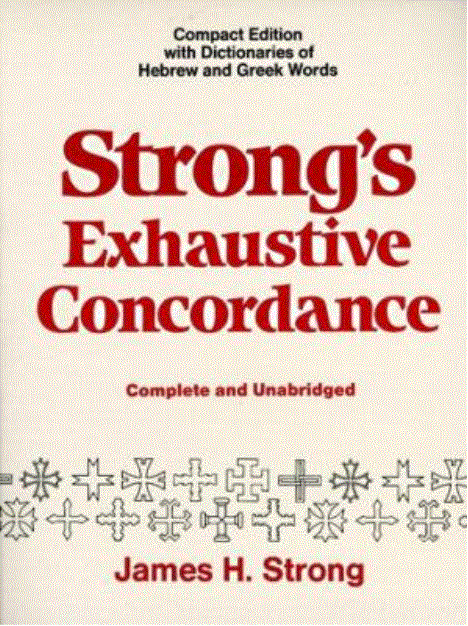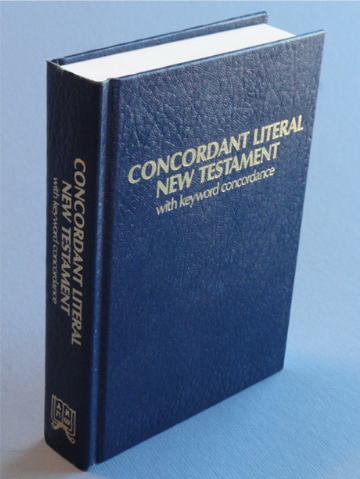What is a Concordance and how to use it?
A concordance is a book that contains an alphabetical listing of words in the Bible and verses where those words are found. Usually, a concordance will consist of two parts. First, the concordance itself which lists the words and verses where they are found. Second is the Hebrew-Aramaic and Greek dictionaries. Both parts are instrumental in doing word studies of a particular word in the Bible. It is a basic tool and is often one of the most used in Bible study.
Part I
A concordance helps a Bible student dig deeper into the truest meanings of words contained within a particular Bible translation by learning the original word's definition. Different English translations of the Bible frequently translate the original Hebrew, Aramaic, and Greek words differently from each other, which means most concordances are translation-specific. This means that a particular concordance is constructed from a particular Bible translation, such as the King James Version, New International Version Revised Standard Version, Moffatt translation, etc.
A concordance for the New International Version (NIV) will not help you find much in the King James Version (Authorized Version), simply because those two translations use different English words.
For example the popular Strong’s Exhaustive Concordance is based on the King James Version. This concordance contains every word found in the King James Version. Many Bibles have a very basic concordance included in the back pages, but there are some concordances available that contain every single word in the Bible. These are called "exhaustive" concordances. The most commonly used exhaustive concordance is Strong's Exhaustive Concordance of the Bible.
In Strong’s, for example, each English word is assigned a number that corresponds to the original Greek or Hebrew word. The Old Testament (Hebrew) words are numbered 0001—8674 beginning with the letter H; the New Testament (Greek) words are numbered 0001—5624 beginning with the letter G. Strong’s includes Hebrew and Greek dictionaries at the back of the concordance, allowing you to easily look up the meaning of the original word behind every word in the Bible.
If you have a New International Version Bible, you should use a concordance based on that particular version, not Strong’s Exhaustive Concordance.
See https://www.Biblegateway.com/resources/resource-interlinear.
How to use it
There is a three-step process to using a concordance.
First, choose a word in the verse you are studying and want to know more about.
Second, look up that word and verse in the concordance section of the concordance.
Third, use the reference number to look up the word in the dictionary section to see the definition and how that word is frequently translated into English.
Here are two examples using verses from two of my web pages.
Matthew 23:33 (KJV) Ye serpents, ye generation of vipers, how can ye escape the damnation of hell?
1 Hell in Strongs Exhaustive Concordance number G1067.
2 The original Greek word is γέεννα (Gehenna.)
3 Gehenna is of Hebrew origin (1516 and 02011); meaning a valley of (the son of) Hinnom; ge-henna (or Ge-Hinnom), a valley near Jerusalem where refuse and bodies of criminals were thrown.
Matthew 16:18 (KJV) And I say also unto thee, That thou art Peter, and upon this rock I will build my church; and the gates of hell shall not prevail against it.
1 Here Hell is Strongs Exhaustive Concordance number G86.
2 The original Greek word is ᾅδης (hades).
3 Means grave or unseen.
Strong's Exhaustive Concordance of the Bible was constructed by a team of more than a hundred scholars under the direction of Dr. James Strong (1822–1894) and first published in 1890. Dr. Strong was Professor of exegetical theology at Drew Theological Seminary. The Strong's Concordance is an exhaustive cross-reference of every word in the King James Bible cross referenced to lexicons of the original languages of the Bible.

https://strongsconcordance.org/
Several Bible concordances are found online and are available to use free of charge. You can also buy paper copies of most concordances from a Bible book store. Concordances of various English Bible translations can be purchased online as well.
Part II
In Part1 we covered the importance of using a concordance to find the accurate meaning of the words of scripture in English from the inspired original text. The most reliable authentic texts are the Codex Sinaiticus, the Codex Vaticanus, and the Codex Alexandrinus. It would be ideal if a person would be fluent in the original languages of Hebrew, Chaldee and Greek. That would give the reader a fairly accurate meaning of the original words. Since almost no one is able to do this, he or she must rely on the next best method of accurate translation. This is where the concordant method is the next best thing. There are just a few translations of the Bible which use the concordant method of translation. The main ones are Youngs Literal Translation, Rotherham’s Emphasized Bible and the Concordant Literal Version. The best of these three is the Concordant Literal Version (CLV).
It was A.E. Knock who painstakingly produced the Concordant Literal Version of the Bible. He devoted a lifetime to the development of a concordant (meaning harmonious and linguistically consistent) Bible translation of the Sacred Scriptures. His goal was to produce a Bible that was as accurate and literal as the constraints of idiom and good diction would permit. The Concordant Version uses a method of translation that takes into account the exceptional perfection of the scriptural writings, even to the minutest detail (Matt.5:18).
Though the Concordant Version includes many technical features, which can be of great value to the advanced student, its greatest benefit is to the ordinary reader. It is intended to be read, carefully and thoughtfully, whether in devotional reading or study.
However, because of differences in idiom between languages, a “word-for-word” translation is impractical if not impossible. What is needed, then, is a version that is translated in such a way so as to be concordant
(essentially accurate, being true to the original), yet easily readable as a literary work.
The Concordant Version is an English translation of the Bible compiled by the Concordant Publishing Concern (https://www.concordant.org/), which was founded by A. E. Knoch in 1909. Mr.Knoch compiled the Concordant Version in such a way as to put the English reader who lacks a formal knowledge of Koine Greek in possession of all the vital facts of the most ancient codices: Codex Vaticanus, Codex Sinaiticus, and Codex Alexandrinus.
The Concordant Publishing Concern (CPC) describes what distinguishes its work from that of others in an article titled About the Concordant Publishing Concern, published on its website given in the previous paragraph.
Also more detailed information on this superb bible version can be found at
https://en.wikipedia.org/wiki/Concordant_Version#cite_note-1.
I highly recommend the Concordant Literal Version of the New Testament and the Concordant Literal Version of the Old Testament. Both can be access for free at the CPC web site or purchased in hard copy from them. Truly, you will not find a more accurate English translation any where else.
Ephesians 1:17-18 (Concordant Literal Version)
vs17 that the God of our Lord Jesus Christ, the Father of glory, may be giving you a spirit of wisdom and revelation in the realization of Him,
vs18 the eyes of your heart having been enlightened, for you to perceive what is the expectation of His calling, and what the riches of the glory of the enjoyment of His allotment among the saints.
Go to Home Page

